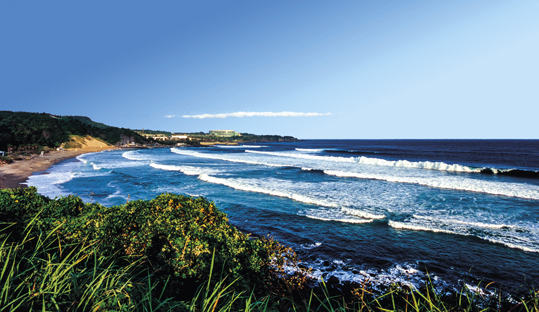Stormrider Guide to surfing Jeju Do
South Korea, EAST ASIA
|
 Jungmun Beach, John Callahan/SurfExplore
Jungmun Beach, John Callahan/SurfExplore
|
Summary
|
+ Powerful typhoon waves
|
- Inconsistent swells
|
|
+ Beaches and lava reefs
|
- Short surf season
|
|
+ World Heritage island
|
- Unpredictable typhoon tracks
|
|
+ Great tourism facilities
|
- Over-protective lifeguards
|
|
|
Lying off the southwest coast of the Republic of Korea, volcanic Jeju Island (Jejudo) is dominated by the lofty central peak of Halla mountain, which slopes steeply down to the north and south coasts, surrounded by 368 smaller volcanoes. The rocky coastline is short on sandy beaches so Jungmun in the south is the centre of surf culture on the island, where beach, reef and pointbreaks can be ridden. Koreans rarely swim in the sea, even when itÕs flat, so most lifeguards are over-cautious, particularly when there is typhoon swell, but a nucleus of local surfers are slowly altering these attitudes and loads more Koreans are learning to surf.
When to Go
Swell arrives from three sides, but lows in the Yellow Sea and NE windslop from the Sea of Japan is usually low quality. Typhoon swells winding up in the Philippine Sea need to track NW and send SSE-SSW swell between Taiwan and Japan so the best season is from June to October. Combine the skinny swell window with strong winds that often change direction many times during the day and you soon realise this is a fickle destination. Tides are semi-diurnal with diurnal inequality and spring tides rarely exceed 2m. Download a tide chart in English.
Surf Spots
Statistics |
J
|
F
|
M
|
A
|
M
|
J
|
J
|
A
|
S
|
O
|
N
|
D
|
| dominant swell |
N -E |
N -E |
N -SW |
N -SW |
N -SW |
N -E |
| swell size (ft) |
2 |
1 |
1-2 |
2 |
2-3 |
2 |
| consistency (%) |
30 |
20 |
10 |
40 |
50 |
30 |
| dominant wind |
NW -N |
NW -N |
NE -SW |
S -SW |
N -NE |
NW -N |
| average force |
F4-F5 |
F4 |
F3-F4 |
F3 |
F4 |
F4 |
| consistency (%) |
66 |
44 |
41 |
36 |
50 |
57 |
| water temp (C) |
12 |
13 |
18 |
24 |
23 |
17 |
| wetsuit |
4/3 |
4/3 |
3/2 |
boardshorts |
springsuit |
3/2 |
|
Travel Information
Weather
Jeju experiences both subtropical oceanic and temperate climates, so the winters are generally long, cold and dry, while summers are short, hot and humid. Spring and autumn are pleasant but short in duration. Temps range between 15¡C-30¡C (59-86¼F) in summer and 3¡C-16¡C (37-61¼F) during winter. Use a 4/3mm and boots mid winter, 3/2 from November to June and a springy or boardshorts from July through October.
|
Lodging and Food
Shilla Cheju Hotel super deluxe dbl room with ocean view is $470/night. In Seogwipo City, Daemyung Green Ville, New Kyongnam, Kal Seogwipo or Paradise Hotel are cheaper at $70-150/n. Jeju Guest-house, 25min N of Jungmun is $30/day. Meals are cheap: $7-12 for a full meal. Try kimchi, pickled fermented cabbage.
|
Nature and Culture
Visit the longest lava cave in the world. Women divers (Haenyeo) in ancient wetsuit and goggles, collect seaweed, shellfish and sea urchins, then sell them on the roadside. Sungsan`s Sunrise Peak is the main tourist site. Many trails (Yongshil, Orimok) and waterfalls.
|
|
